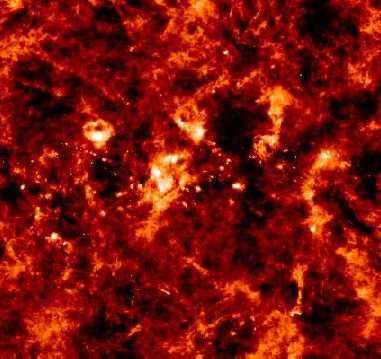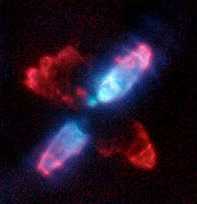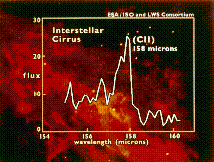





|
BETWEEN THE STARS
We often think of the vast areas of space between the stars as being
completely empty. However, this is not really true. Much of the space
between the stars is filled with gas (primarily hydrogen and helium)
and tiny pieces of solid particles or dust (composed mainly of carbon,
silicon and oxygen).
In some places this interstellar material is very dense, forming nebulas.
In other regions the gas and dust density is very low.
The image to the right shows an infrared view of the gas and dust in our galaxy
along the plane of our Milky Way galaxy. Here you can see areas of dense
gas and dust as well as areas which are nearly empty.
|

W. Waller and F. Varosi (GSFC), IRAS, SkyView, NASA |
Interstellar matter radiates strongly in the infrared. Most of this gas and dust originates from the death of stars which either exploded (supernova) or blew off their outer layers, returning their material to interstellar space. From this material, new stars are formed. Often, the gas and dust between the stars can be detected only in the infrared. By using infrared detectors, astronomers can penetrate the often invisible interstellar gas and dust clouds and gain much information about their composition and structure. Infrared astronomy has also resulted in the detection of several types of complex interstellar molecules. Below are two infrared images taken by NICMOS of material being ejected into space by dying stars.


A surprise discovery from the IRAS mission was that space is filled with faint wisps of dust which cannot be seen in visible light. This has been given the name "infrared cirrus" because it resembles the cirrus clouds in the Earth's atmosphere. Infrared cirrus is very cold (15-30 K or -433 to -406 F) and can only be detected in the infrared. Its temperature is due to dust grains being slightly heated by starlight.


IRAS image of cirrus at the south celestial pole and ISO-LWS spectra of infrared cirrus
|
|